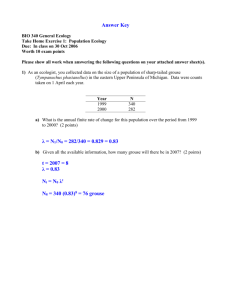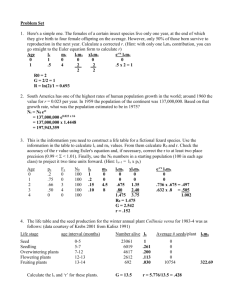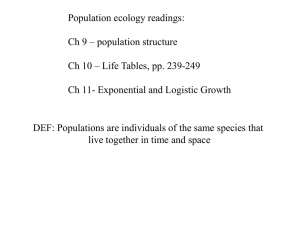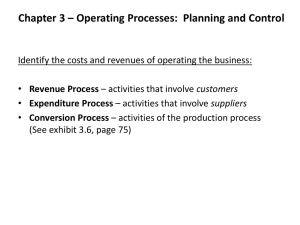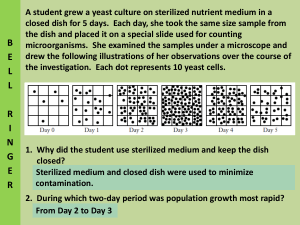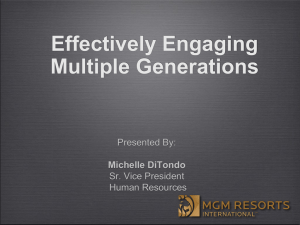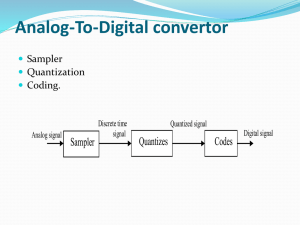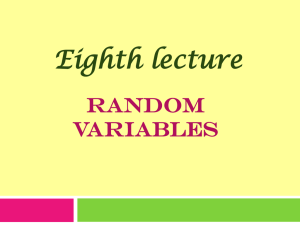Document
advertisement
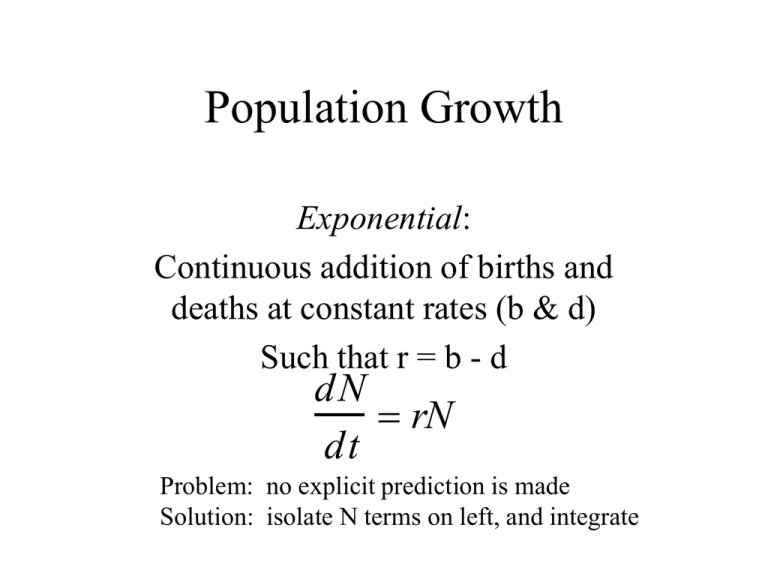
Population Growth Exponential: Continuous addition of births and deaths at constant rates (b & d) Such that r = b - d dN rN dt Problem: no explicit prediction is made Solution: isolate N terms on left, and integrate Result of the integration: Nt N0e Exponential growth 800 700 N (t) 0 1 2 3 4 5 6 7 8 9 10 log N 1 0 0 4 .6 0 5 1 7 0 1 9 600 1 0 5 .1 2 7 1 1 4 .6 5 5 17019 1 1 0 .5 1 7 0 9 2 4 .7 0 5 1 7 0 1 9 1 1 6 .1 8 3 4 2 4 4 .7 5 5 17019 500 1 2 2 .1 4 0 2 7 6 4 .8 0 5 1 7 0 1 9 1 2 8 .4 0 2 5 4 2 4 .8 5 5 1 7 0 1 9 400 1 3 4 .9 8 5 8 8 1 4 .9 0 5 1 7 0 1 9 1 4 1 .9 0 6 7 5 5 4 .9 5 5 1 7 0 1 9 300 1 4 9 .1 8 2 4 7 5 .0 0 5 17019 1 5 6 .8 3 1 2 1 9 5 .0 5 5 1 7 0 1 9 1 6 4 .8 7 2 1 2 7 5 .1 0 5 17019 200 r=0.05 N(t) time, t: rt 100 0 0 10 20 30 Time 40 50 Exponential growth relationships Exponential growth 800 40 700 35 600 Slope of Curve on left 500 N(t) dN rN dt 30 400 300 200 Nt N0e 100 10 20 30 40 Time Slope of this curve Increases with density 20 15 10 5 rt 0 0 0 0 25 50 100 200 300 400 500 Density Slope of line = r 600 700 800 Exponential growth, log scale N (t) 0 1 2 3 4 5 6 7 8 9 10 log N 1 0 0 4 .6 0 5 1 7 0 1 9 1 0 5 .1 2 7 1 1 4 .6 5 5 1 7 0 1 9 1 1 0 .5 1 7 0 9 2 4 .7 0 5 1 7 0 1 9 1 1 6 .1 8 3 4 2 4 4 .7 5 5 1 7 0 1 9 1 2 2 .1 4 0 2 7 6 4 .8 0 5 1 7 0 1 9 1 2 8 .4 0 2 5 4 2 4 .8 5 5 1 7 0 1 9 1 3 4 .9 8 5 8 8 1 4 .9 0 5 1 7 0 1 9 1 4 1 .9 0 6 7 5 5 4 .9 5 5 1 7 0 1 9 1 4 9 .1 8 2 4 7 5 .0 0 5 1 7 0 1 9 1 5 6 .8 3 1 2 1 9 5 .0 5 5 1 7 0 1 9 1 6 4 .8 7 2 1 2 7 5 .1 0 5 1 7 0 1 9 7 6 5 4 ln(N) time, t: ln Nt ln N0 rt 3 Linear increase of log values with time is a sign of exponential growth 2 1 0 0 10 20 30 time 40 50 Geometric Growth Time is measured in discrete (contant) chunks Simplest approach: Generations are the time unit R0: Average number of offspring produced per individual, per lifetime-- Factor that a population will be multiplied by for each generation. Often called the Net Rate of Increase. NT N0 R T 0 Time is measured in generations in this equation. Relationship between R0 and r A population growing for one generation should show the same result using either of the following equations: Continuous, where t=t (t “generation time”) Discrete, where T=1 generation Nt N0e NT N0 R T 0 rt Nt N0 e rt N1 N0 R N 0R0 1 0 If these give the same result, then rt N0e N0 R0 R0 and r rt N0e N0 R0 rt e R0 rt ln R0 r ln R0 t So! Information about R and t can lead us to r Ways of finding R0 and t R0 lx mx x xl m t l m x x x x x x Cohort study x 0 1 2 3 4 nx 43 21 10 2 0 total offs pring 44 32 2 0 Survivorship calculations x 0 1 2 3 4 nx 43 21 10 2 0 total offs pring 44 32 2 0 lx lx 1 0 .4 8 8 3 7 2 0 9 0 .2 3 2 5 5 8 1 4 0 .0 4 6 5 1 1 6 3 0 1.2 Survivorship, lx 1 0.8 0.6 lx 0.4 0.2 0 0 0.5 1 1.5 2 2.5 Age, x 3 3.5 4 4.5 Fecundity calculations x 0 1 2 3 4 nx 43 21 10 2 0 total offs pring 44 32 2 0 lx mx 1 0 0 .4 8 8 3 7 2 0 9 2 .0 9 5 2 3 8 1 0 .2 3 2 5 5 8 1 4 3 .2 0 .0 4 6 5 1 1 6 3 1 0 0 mx 3.5 Fecundity, mx 3 2.5 2 mx 1.5 1 0.5 0 0 1 2 Age, x 3 4 Age-specific reproduction x 0 1 2 3 4 nx 43 21 10 2 0 total offs pring lx mx lxmx 1 0 0 4 4 0 .4 8 8 3 7 2 0 9 2 .0 9 5 2 3 8 1 1 .0 2 3 2 5 5 8 1 3 2 0 .2 3 2 5 5 8 1 4 3 .2 0 .7 4 4 1 8 6 0 5 2 0 .0 4 6 5 1 1 6 3 1 0 .0 4 6 5 1 1 6 3 0 0 0 0 N et Rate of I nc reas e= 1 .8 1 3 9 5 3 4 9 Offspring per initial individual, lxmx lxmx 1.2 Generation time 1 0.8 0.6 lxmx 0.4 Ro=area under curve 0.2 0 0 1 2 Age, x 3 4 nx 43 21 10 2 0 Generation Time, t total offs pring lx mx lxmx xlxmx 1 0 0 0 4 4 0 .4 8 8 3 7 2 0 9 2 .0 9 5 2 3 8 1 1 .0 2 3 2 5 5 8 1 1 .0 2 3 2 5 5 8 1 3 2 0 .2 3 2 5 5 8 1 4 3 .2 0 .7 4 4 1 8 6 0 5 1 .4 8 8 3 7 2 0 9 2 0 .0 4 6 5 1 1 6 3 1 0 .0 4 6 5 1 1 6 3 0 .1 3 9 5 3 4 8 8 0 0 0 0 0 N et Rate of I nc reas e= 1 .8 1 3 9 5 3 4 9 2 .6 5 1 1 6 2 7 9 G eneration time= 1 .4 6 1 5 3 8 4 6 r~ lxmx Offspring per initial individual, lxmx x 0 1 2 3 4 0 .2 1 6 0 1 9 0 9 1.2 Generation time 1 0.8 0.6 lxmx 0.4 Ro=area under curve 0.2 0 0 1 2 Age, x 3 4 Approximate r x 0 1 2 3 4 nx 43 21 10 2 0 total offs pring lx mx lxmx xlxmx 1 0 0 0 4 4 0 .4 8 8 3 7 2 0 9 2 .0 9 5 2 3 8 1 1 .0 2 3 2 5 5 8 1 1 .0 2 3 2 5 5 8 1 3 2 0 .2 3 2 5 5 8 1 4 3 .2 0 .7 4 4 1 8 6 0 5 1 .4 8 8 3 7 2 0 9 2 0 .0 4 6 5 1 1 6 3 1 0 .0 4 6 5 1 1 6 3 0 .1 3 9 5 3 4 8 8 0 0 0 0 0 N et Rate of I nc reas e= 1 .8 1 3 9 5 3 4 9 2 .6 5 1 1 6 2 7 9 G eneration time= 1 .4 6 1 5 3 8 4 6 r~ 0 .2 1 6 0 1 9 0 9 Assumptions of exponential or geometric growth projections Constant lx and mx schedules This implies that reproduction and survival will not change with density This also implies that any changes in physical or chemical environment have no influence on survival or reproduction No important interactions with other species if age-specific data are used, assume stable age distribution. Suppose we let lx, mx and t vary with density Bottom line: let r (per capita growth rate) vary with N r dN/Ndt 0 0 K N Density-dependent growth r dN/Ndt -r/K 0 0 N Y = A + BX dN r r N Ndt K K Logistic equation dN N rN 1 dt K Predictive form: Nt K K N 0 rt 1 e N0 Human rates of change vs N 0.025 0.02 0.015 y = -0.0019x + 0.0254 0.01 0.005 0 0 2 4 6 8 10 12 14 16 Projection based on Logistic model: 14 12 10 8 6 4 2 0 1950 2000 2050 2100 2150 Earlier US projection, similar approach: Logistic Examples Full-loop (2x the bacteria) Half-loop (half that on right) Paramecium, 2 species, growing for 8 days at high <r> and low <l> resource levels. Scale has been stretched on right to be equivalent to that on the left More logistic examples Growth of flour beetles in flower, In containers holding different amts of flour Growth of a zooplankton crustacean, Moina, at different temperatures Drosophila studies Evolution of K in Drosophila Post-radiation Hybrid Control Inbred Results suggest that K responds to an increase in genetic variation, And that it changes gradually through time in response to selection. Assumptions of Logistic Growth Constant environment (r and K are constants) Linear response of per capita growth rate to density Equal impact of all individuals on resources Instantaneous adjustment of population growth to change in N No interactions with species other than those that are food Constantly renewed supply of food in a constant quantity Discrete Model for Limited Growth Same assumptions, except population grows in bursts with each Generation-- built-in time lag Models of this sort show the potential influence that a time lag can have on population change. Nt Nt 1 N t rNt 1 K Simple model, complex behavior Discrete Model 1200 1000 N 800 600 400 200 0 0 20 40 60 80 Time (generations) R = 0.1, K = 1000 100 120 Simple model, complex behavior Discrete Model 1200 1000 N 800 600 400 200 0 0 20 40 60 80 Time (generations) R = 1.9, K = 1000 Damped oscillation 100 120 Simple model, complex behavior Discrete Model 1400 1200 1000 N 800 600 400 200 0 0 20 40 60 Time (generations) r= 2.2, K = 1000 Limit cycle 80 100 120 Simple model, complex behavior Discrete Model 1400 1200 1000 N 800 600 400 200 0 0 20 40 60 Time (generations) r= 2.5, K = 1000 4-point cycle 80 100 120 Simple model, complex behavior Discrete Model 1400 1200 1000 N 800 600 400 200 0 0 20 40 60 80 Time (generations) r= 2.58, K = 1000 8-point cycle 100 120 Simple model, complex behavior Discrete Model 1400 1200 1000 N 800 600 400 200 0 0 20 40 60 Time (generations) r= 2.7, K = 1000 Erratic 80 100 120 Chaos Discrete Model 1400 1200 1000 N 800 600 400 200 0 0 20 40 60 Time (generations) r= 3, K = 1000 80 100 120 Overshoot, Crash, Extinction Discrete Model 1600 1400 1200 N 1000 800 600 400 200 0 0 20 40 60 80 Time (generations) r= 3.000072, K = 1000 100 120 Concerns about Chaos Biological populations don’t appear to have the growth capacity to generate chaos, but this shows the potential importance of time lags. More complicated models can be even more sensitive Some systems might be completely unpredictable Evolution of Life Histories Life history features: Rates of birth, death, population growth Patterns of reproduction and mortality Behavior associated with reproduction Efficiency of resource use, and carrying capacity Anything that affects population growth Patterns More patterns Tradeoff
